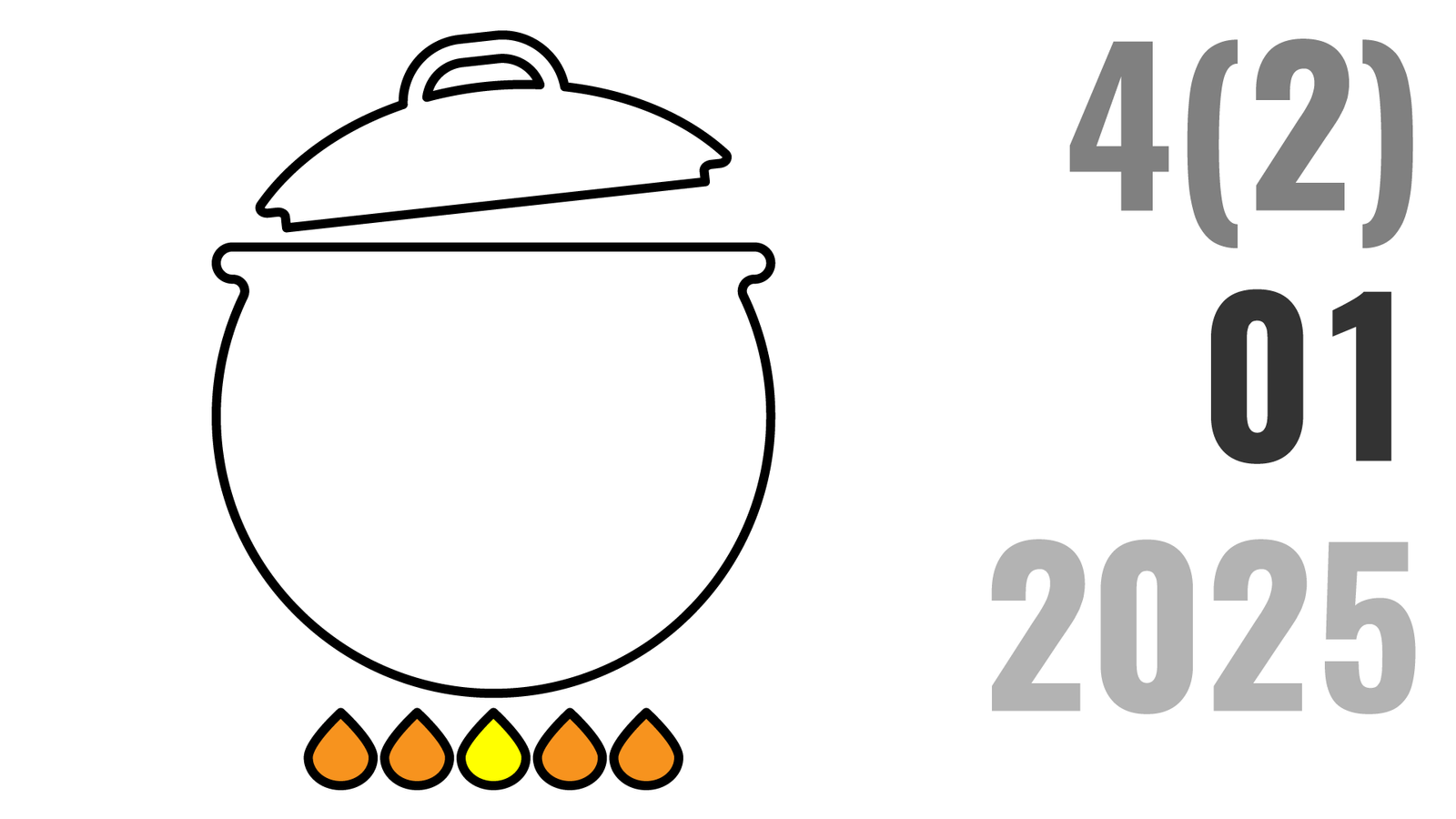Fermentación Espontánea en masa madre una alianza ancestral entre microorganismos y panaderos.
DOI:
https://doi.org/10.70221/rgc.v4i2.89Palabras clave:
Fermentación espontanea, Masa madre, Bacterias lácticas, FODMAP, FitatosResumen
La masa madre es una biotecnología fermentativa ancestral basada en la simbiosis entre bacterias ácido-lácticas y levaduras nativas, capaces de transformar harina y agua en un pan con propiedades sensoriales y nutricionales. A diferencia de los cultivos industriales, esta fermentación espontánea crea un ecosistema microbiano único que varía según el entorno, el tipo de harina, la hidratación y la temperatura. Durante el proceso se generan ácidos, alcoholes y ésteres que aportan aroma y sabor, se degrada ácido fítico mejorando la absorción mineral, y se reducen los carbohidratos fermentables (FODMAPs), favoreciendo la digestibilidad. Además, ciertas cepas como Lpb. plantarum G8 producen compuestos antifúngicos que extienden la vida útil del pan sin conservantes, esta revisión conecta ciencia y tradición, posicionando la masa madre como una herramienta actual para una panificación más saludable y sostenible.
Descargas
Referencias
Akamine, I. T., Mansoldo, F. R. P., & Vermelho, A. B. (2023). Probiotics in the Sourdough Bread Fermentation: Current Status. Fermentation, 9(2). https://doi.org/10.3390/fermentation9020090 DOI: https://doi.org/10.3390/fermentation9020090
Calvert, M. D., Madden, A. A., Nichols, L. M., Haddad, N. M., Lahne, J., Dunn, R. R., & McKenney, E. A. (2021). A review of sourdough starters: ecology, practices, and sensory quality with applications for baking and recommendations for future research. PeerJ, 9, 1–37. https://doi.org/10.7717/peerj.11389 DOI: https://doi.org/10.7717/peerj.11389
Cristofori, F., Francavilla, R., Capobianco, D., Dargenio, V. N., Filardo, S., & Mastromarino, P. (2020). Bacterial-Based Strategies to Hydrolyze Gluten Peptides and Protect Intestinal Mucosa. Frontiers in Immunology, 11(November). https://doi.org/10.3389/fimmu.2020.567801 DOI: https://doi.org/10.3389/fimmu.2020.567801
De Vuyst, L., & Neysens, P. (2005). The sourdough microflora: Biodiversity and metabolic interactions. Trends in Food Science and Technology, 16(1–3), 43–56. https://doi.org/10.1016/j.tifs.2004.02.012 DOI: https://doi.org/10.1016/j.tifs.2004.02.012
Di Cagno, R., Rizzello, C. G., De Angelis, M., Cassone, A., Giuliani, G., Benedusi, A., … Gobbetti, M. (2008). Use of selected sourdough strains of Lactobacillus for removing gluten and enhancing the nutritional properties of gluten-free bread. Journal of Food Protection, 71(7), 1491–1495. https://doi.org/10.4315/0362-028X-71.7.1491 DOI: https://doi.org/10.4315/0362-028X-71.7.1491
Gobbetti, M., De Angelis, M., Corsetti, A., & Di Cagno, R. (2005). Biochemistry and physiology of sourdough lactic acid bacteria. Trends in Food Science and Technology, 16(1–3), 57–69. https://doi.org/10.1016/j.tifs.2004.02.013 DOI: https://doi.org/10.1016/j.tifs.2004.02.013
Gobbetti, Marco, De Angelis, M., Di Cagno, R., Calasso, M., Archetti, G., & Rizzello, C. G. (2019). Novel insights on the functional/nutritional features of the sourdough fermentation. International Journal of Food Microbiology, 302(April), 103–113. https://doi.org/10.1016/j.ijfoodmicro.2018.05.018 DOI: https://doi.org/10.1016/j.ijfoodmicro.2018.05.018
Gobbetti, Marco, Minervini, F., Pontonio, E., Di Cagno, R., De Angelis, M., Minervini, F., … De Angelis, M. (2016). Drivers for the establishment and composition of the sourdough lactic acid bacteria biota. International Journal of Food Microbiology, 1–49. https://doi.org/https://doi.org/10.1016/j.ijfoodmicro.2016.05.022 DOI: https://doi.org/10.1016/j.ijfoodmicro.2016.05.022
Hammes, W. P., Brandt, M. J., Francis, K. L., Rosenheim, J., Seitter, M. F. H., & Vogelmann, S. A. (2005). Microbial ecology of cereal fermentations. Trends in Food Science and Technology, 16(1–3), 4–11. https://doi.org/10.1016/j.tifs.2004.02.010 DOI: https://doi.org/10.1016/j.tifs.2004.02.010
Koc, F., Arendt, E., Coffey, A., Ross, R. P., & Stanton, C. (2024). Impact of low FODMAP sourdough bread on gut microbiota using an in vitro colonic fermentation model. Frontiers in Microbiology, 15(November), 1–13. https://doi.org/10.3389/fmicb.2024.1496022 DOI: https://doi.org/10.3389/fmicb.2024.1496022
Kurtzman, C. (2011). The Yeasts, a Taxonomic Study (J. Fell & T. Boekhout, eds.). London: Elsevier Inc.
Landis, E. A., Oliverio, A. M., McKenney, E. A., Nichols, L. M., Kfoury, N., Biango-Daniels, M., … Wolfe, B. E. (2021). The diversity and function of sourdough starter microbiomes. ELife, 10, 1–24. https://doi.org/10.7554/eLife.61644 DOI: https://doi.org/10.7554/eLife.61644
McKenney, E. A., Nichols, L. M., Alvarado, S., Hardy, S., Kemp, K., Polmanteer, R., … Dunn, R. R. (2023). Sourdough starters exhibit similar succession patterns but develop flour-specific climax communities. PeerJ, 11, 1–24. https://doi.org/10.7717/peerj.16163 DOI: https://doi.org/10.7717/peerj.16163
Minervini, F., Dinardo, F. R., Celano, G., De Angelis, M., & Gobbetti, M. (2018). Lactic acid bacterium population dynamics in artisan sourdoughs over one year of daily propagations is mainly driven by flour microbiota and nutrients. Frontiers in Microbiology, 9(AUG), 1–15. https://doi.org/10.3389/fmicb.2018.01984 DOI: https://doi.org/10.3389/fmicb.2018.01984
Moroni, A. V., Dal Bello, F., & Arendt, E. K. (2009). Sourdough in gluten-free bread-making: An ancient technology to solve a novel issue? Food Microbiology, 26(7), 676–684. https://doi.org/10.1016/j.fm.2009.07.001 DOI: https://doi.org/10.1016/j.fm.2009.07.001
Mou, T., Xu, R., Li, Q., Li, J., Liu, S., Ao, X., … Liu, A. (2025). Screening of Antifungal Lactic Acid Bacteria and Their Impact on the Quality and Shelf Life of Rye Bran Sourdough Bread. Foods, 14(7), 1–12. https://doi.org/10.3390/foods14071253 DOI: https://doi.org/10.3390/foods14071253
Murniece, R., Reidzane, S., Radenkovs, V., Straumite, E., Keke, A., Kobrin, E., & Klava, D. (2025). Scald Fermentation Time as a Factor Determining the Nutritional and Sensory Quality of Rye Bread. Foods, 1–20. https://doi.org/https://doi.org/10.3390/foods14060979 DOI: https://doi.org/10.3390/foods14060979
Ramos, L., Alonso-Hernando, A., Martínez-Castro, M., Morán-Pérez, J. A., Cabrero-Lobato, P., Pascual-Maté, A., … Mujico, J. R. (2021). Sourdough biotechnology applied to gluten-free baked goods: Rescuing the tradition. In Foods (Vol. 10). https://doi.org/10.3390/foods10071498 DOI: https://doi.org/10.3390/foods10071498

Descargas
Publicado
Número
Sección
Categorías
Licencia
Derechos de autor 2025 Robert Leon-Suarez

Esta obra está bajo una licencia internacional Creative Commons Atribución 4.0.
Usted es libre de:
Compartir — copiar y redistribuir el material en cualquier medio o formato
Adaptar — remezclar, transformar y construir a partir del material, para cualquier propósito, incluso comercialmente. La licenciante no puede revocar estas libertades en tanto usted siga los términos de la licencia
Bajo los siguientes términos:
Atribución — Usted debe dar crédito de manera adecuada, brindar un enlace a la licencia, e indicar si se han realizado cambios. Puede hacerlo en cualquier forma razonable, pero no de forma tal que sugiera que usted o su uso tienen el apoyo de la licenciante.
No hay restricciones adicionales — No puede aplicar términos legales ni medidas tecnológicas que restrinjan legalmente a otras a hacer cualquier uso permitido por la licencia.














